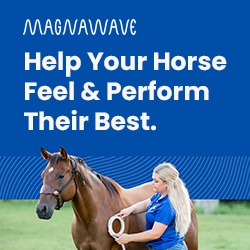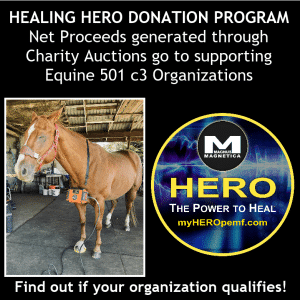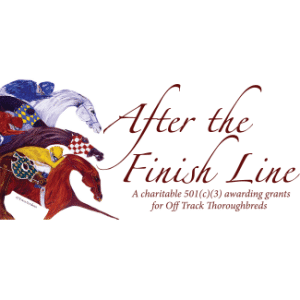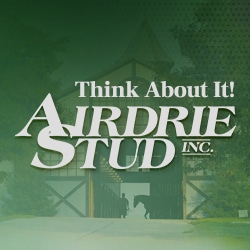Your feed regimen can have a big effect on your horse’s attitude and energy levels.

Bethany P Photography
Feeding a diet high in grain, high in molasses, high in protein, and/or high in minerals and vitamins has been associated with hyper-activity and/or hyper-reactivity in horses. Feeding large amounts of feed at one time regardless of grain composition has also been associated with hyper activity and/or hyper-reactivity in horses. In this issue we discuss what, when and how much to feed an individual horse in order to adjust the “throttle” up or down depending upon your desired objective.
Before we begin, it is important to understand that the feeding program and the exercise program must fit together like a hand inside a glove. When the exercise program and the feeding program for an individual horse are not balanced correctly, the result can be an unfocused, lethargic or hyper-active horse. For example, you would expect a fit horse to become hyper-active if it is on stall rest but being fed as if it is going to be competing in a four star event next weekend.
In most cases, hyper-activity is a result of too much energy being fed and not enough energy being exercised out. Likewise, lethargic attitudes, if not a result of illness or lameness, are usually a result of more energy being exercised out compared to the amount of energy being fed. Therefore, if your horse is too hyper or not energetic enough the first thing to do is ensure that the amount of energy in versus the amount of energy out is correctly balanced.
Where’s the energy in a horse’s diet?
Before we investigate the effect of energy source on equine behavior we need to understand how much energy is supplied by various ingredients in our horse’s diet.
Forage can be extremely variable in total energy content, but forage should be the foundation of every horse’s feeding program meaning a certain amount of forage should be fed to your horse every day. For most performance horses forage supplies between 40 and 70 percent of the total energy intake. This is a fairly wide range and is dependent upon the energy content of the forage and how hard the horse is working. The take home message here is (generally speaking) the higher the percentage the more level headed your horse is going to be. If you want to “hype” your horse up a bit change your forage to one that contains more energy per pound such as a higher quality grass hay, mixed hay or alfalfa hay. If you want to “level” your horse change your forage to a grass hay that contains less energy per pound.
Grains such as oats, corn or barley contain approximately 60 percent more energy per pound compared to average forage sources. Therefore, the more grain you feed the more total energy you provide your horse. If you want to “hype” your horse a bit then increase the amount of grain as a percentage of the total diet. If you want to “level” your horse reduce the amount of grain as a percentage of the total diet. Keep in mind that corn contains more energy per pound compared to barley which contains more energy per pound compared to oats. This, in part, is why corn is considered a “hot” grain, whereas oats are considered a “cool” grain (more on that later).
Protein sources, especially soybean meal may provide as much and in many cases more energy per pound than grains, especially oats. If you feed your horse a higher protein diet and the protein source is primarily soybean meal you may actually be providing your horse more total energy than you were previously. As a result, your horse’s attitude shifts to the “hyper” side of the scale. Protein intake will not in itself “hype” a horse up unless the total protein intake becomes excessive compared to the horse’s requirement.
Fat contains more than 2.5 times as much energy per pound compared to grain and 4 times as much energy per pound compared to grass hay. Therefore, if you want to increase your horse’s total energy intake increasing the fat content of the diet is a very effective way to accomplish this goal.
Minerals and vitamins do not provide energy in the form of calories but they do play important roles in the conversion of forages, grains, protein sources and fat sources into cellular energy. Horses that are deficient in minerals and vitamins cannot effectively metabolize energy into utilizable cellular energy and may actually exhibit nervous behavior and become a bit hyper-reactive. Likewise, horses that receive too much mineral and vitamin fortification may also become hyper-reactive. Therefore, it is important that your horse’s mineral and vitamin intake meet your horse’s requirement but avoid excessive intakes. The most common cause of excessive mineral and vitamin intakes is off label use of feed products and supplements containing high concentrations of minerals and vitamins. If you are supplementing minerals and vitamins to your horse be sure that your horse actually needs them and do not double up on minerals and vitamins by feeding more than one product containing similar mineral and vitamin compositions.
Energy sources affect your horse’s attitude
Even if you correctly balance your horse’s energy intake with his/her energy output via exercise the composition of your horse’s diet can still help to either “hype” him up or “level” him out.
The glycemic effect of your horse’s diet can be used as a general guideline to measure the “hotness” or “coolness” of your horse’s diet. Glycemic effect refers to the rate and amplitude of the increase in blood glucose due to diet composition and feed intake. Diets containing very high amounts and/or percentages of grain will have a higher glycemic effect compared to diets with lower grain content. Likewise, grain mixes with greater proportions of corn will have higher glycemic effects compared to grain mixes comprised primarily of oats. Therefore, if you want to push your horse’s throttle forward a bit you will want to increase the amount of grain you feed. If you want to push your horse’s throttle even further forward increase the proportion of corn in the grain mix and/or feed larger amounts of grain at one time. Feeding small amounts of grain at one time helps to keep the glycemic effect low and your horse more “level”.
On the other hand, if your objective is to support a high energy demand without “hyping” your horse up you will be better off supplying a greater proportion of the total energy intake from fat, fiber and forage. Since fat provides a lot of energy per pound, increasing the fat content of your horse’s diet allows you to meet your horse’s energy requirement with fewer pounds of feed per day and lower proportions of grain. It is very important to understand that in order for your horse to effectively utilize fat as an energy source two things must be present: 1) you have to feed the same level of fat every day for approximately 3 weeks before your horse’s metabolism adjusts to effectively utilize fat; and 2) you horse needs to be exercised at a level that stimulates your horse’s metabolism to utilize fat as a cellular energy source. In other words, horses need to be worked at moderate to intense levels before higher dietary fat levels will make much difference in your horse’s cellular metabolism.
Feeding large amounts of protein (more than twice the requirement in terms of grams per day) can also increase your horse’s reactivity. However, excessive protein intakes usually do so in a negative way meaning your horse’s reactivity can be classified more as a nervous energy rather than just being “full of themselves.” This is a result of your horse having to flush out excessive amounts of nitrogen and urea produced in the body as a result of excessive protein intakes. Therefore, feeding excessive amounts of protein is not recommended even if your objective is to push your horse’s throttle forward a bit.
When to feed in relation to when to exercise
Research has demonstrated that horse’s will utilize dietary energy sources most efficiently if they are exercised at least four hours after receiving a grain meal. The larger the grain meal and the higher the glycemic effect of the grain mix, the greater will be the influence of the four hour lag time between feeding and exercising. Horses that are fed a diet that is 100% forage will exhibit no benefit from waiting this long between eating and exercising.
Summary
Hopefully this short introduction has helped you understand that to effectively adjust your horse’s throttle up or down you need to:
- Understand which dietary components provide more versus less amounts of energy per pound
- Understand which dietary components will have the greatest or the least glycemic effects
- Understand that mineral and vitamins should be fed to meet the requirement but should not be either deficient or excessive
- Understand that protein intakes should meet the requirement but should not be deficient or excessive
- Understand that dietary composition and the size of individual grain meals can determine the best time to exercise following the ingestion of grain.










